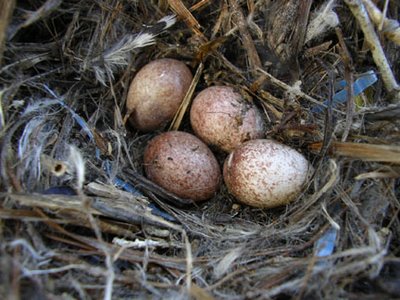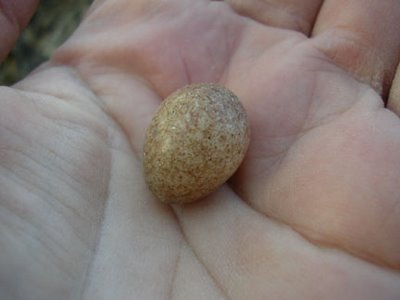
At the beginning of the season (just a few weeks off now) male house wrens find suitable territory and start filling potential nesting cavities (including bluebird houses) with twigs. Between this and singing their hearts out they attract females who inspect the sites, and if he's lucky, picks one, cleans it up (removing some or all of the twigs if necessary) and builds a nest. Here's a picture of the nesting box in use last summer (from the post: And Changed Again).

If he's luckier still two of his potential nest sites will be chosen by two different females. I don't know if this has happened in the yard--there are usually three nests around, two in boxes and one in the scrub at back property line--and two nestings in at least of these locations, so there's too much wren action going on all season for me to figure out how many males are involved.
The nest is deep in the cavity at the back, fronted by a wall of sticks that blocks the opening, leaving just enough space for a wren to slip through. When you open up the box you see is a mass of twigs. Pull it out, and there's a fairly conventional little nest of pine needles, grasses, feathers, bits of shattered plastic tarp (the blue bits in the photo), and other fine nesting materials, behind it.

Normal clutch size is five to eight eggs. This nest may have been abandoned before the wren had finished laying eggs. I broke one open and found no sign of embryo development, just a dried scum, so it was likely abandoned soon after these eggs were laid. Why? I don't know. I remember noticing activity at this house start up and stop rather suddenly towards the end of the season last year. Something wrong with the house or location maybe? The tree lost its leaves early, in preparation for dying or because it had died (an elm--due to Dutch elm disease they live a short life but a merry one--young elms spring up everywhere). Or perhaps the female wren came to grief.

Birds by Bent has an excellent chapter about the house wren. Cornell claims to have an audio file of its song here, but I couldn't access it for some reason. Project Wildspace has a recording of the song here.
I'm looking forward to the return of the house wrens to the yard, but by the end of the summer I'll be a little tired of their scolding. For a bird that seems perfectly content to nest among us humans, it never seems happy to actually see us!







2 comments:
are you handling the eggs? my slow dialup x'd out the photos before I could view them.
I miss these little feists since moving into the woods. We had one year ago that picked up a very large stick while building one of his many nests. He struggled and tugged and pushed and shove and just could not get that stick into the entrance hole. Then he sang at it! Like the power of that tiny voice could move the stick, it was just too funny to watch.
(glad you've seen Upland Sandpipers too- they nest up in Kirtlands breeding grounds and I love their bubbling calls- wonderful birds)
Hi Cindy:
Yes, these are eggs from last year--nothing in them, so I took a picture of one in my hand to show the size. It will be a few weeks more, probably, before they return to nest again. I can imagine your wren singing at his stick--fierce hard workers, the wrens.
Post a Comment